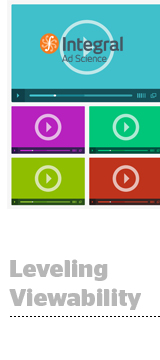 Integral Ad Science on Thursday rolled out pre-bid viewable segments for video that will let advertisers target against different viewability thresholds.
Integral Ad Science on Thursday rolled out pre-bid viewable segments for video that will let advertisers target against different viewability thresholds.
MediaMath is the first demand-side platform (DSP) to adopt Integral’s new pre-bid segments.
Rather than bidding based on historical data, Integral’s pre-bid viewability segments help marketers fine-tune their bids before the fact.
So instead of just ranking the top 20% or 40% of impressions with the strongest viewability results, for example, marketers can now bid on ad impressions that are more likely to be viewable and in-view longer.
Although Integral offered pre-bid targeting segments to DSPs since 2011 – its earliest integrations date back to 2010 with AdMeld when Integral was known as AdSafe – those were largely centered around display.
“What we’ve done with video is a little different and something we feel is way more respective to advertisers,” said David Hahn, SVP of product management for Integral. “The net benefit is the advertiser can say, ‘My threshold for this campaign needs to have at least 70% of impressions in view,’” and adjust bids accordingly.
Although this capability gives advertisers more in the way of matching bids to their preferred viewability levels, it’s not just about a simple upfront selection.
“A higher level of viewability sometimes means less audience coming from a targeting standpoint, so you really want to create this balance of scale versus viewability,” said Aruna Paramasivam, senior director of data and partnerships for MediaMath. “We like to say, ‘Yes, your ad is 90% viewable, but to how many people?’”
Integral believes it has a competitive advantage in terms of scale to solve some of these performance questions. It expanded its partnership with Nielsen last fall, for example, to offer demographic-based viewability measurement across an array of publishers using Nielsen’s Ad Ratings.
In order to predict the probability of whether an ad has the ability to be seen or not, you need to look at a fairly sizable swath of inventory.
Consider a viewability product like Google’s Active View. Despite its lens into domain- and URL-level impressions across AdSense/AdX inventory, in contrast Integral claims it can make predictions at the placement level across publishers (and not necessarily within Google’s own walled garden).
“Google can launch their own segments, but they’re not going to work with MediaMath or Turn’s segments,” Hahn said. “We’ve brought standardized segments into market that [would work consistently] for an agency who might use one DSP for one client and another for another advertiser.”
One challenge was amassing a large enough volume of quality segments given the scarcity of premium placements in video and unique publisher attributes. For instance, some publishers support various specs such as VAST 2.0 on up to VAST 4.0, HTML5/Flash and custom player sizes.
Integral’s acquisition last year of video media quality solution Veenome helped set the foundation for its new video pre-bid segments.
“What we’ll see evolving with the offering will be an introduction of segments that are more specific to Veenome (now Integral Quality Metrics),” Hahn said, including the ability to ensure ads are targeted in-player vs. in-banner, target ads that may have one or multiple video players on a page or high-definition/low-definition attributes.
Video viewability (and viewability in general) is in the early stages, but Hahn predicts more dynamic pricing in programmatic auctions down the pike that will reflect in bid price the probability you’ll reach consumers in a high viewability “bracket” or certain time spent.
“Over time we will see a resetting of the supply and demand curve,” he added, “that will move in favor of ads that are seen longer and that have more levels of engagement with a specific user segment.”












